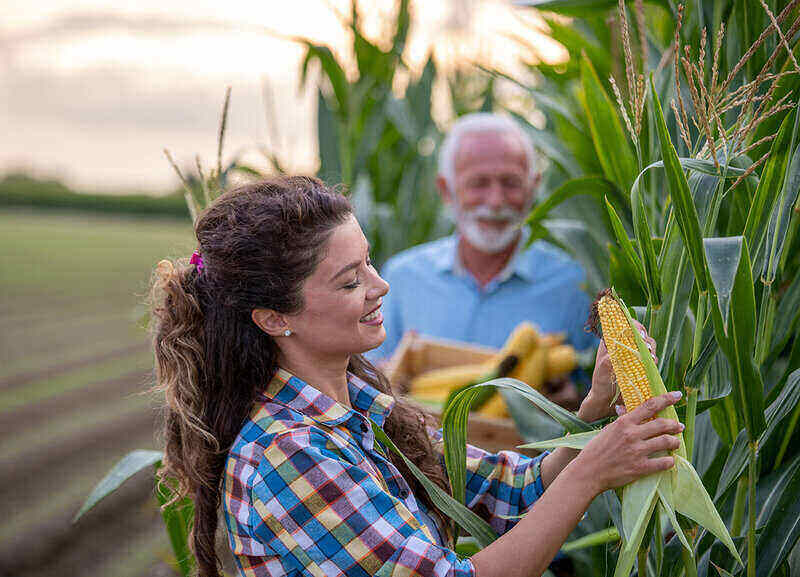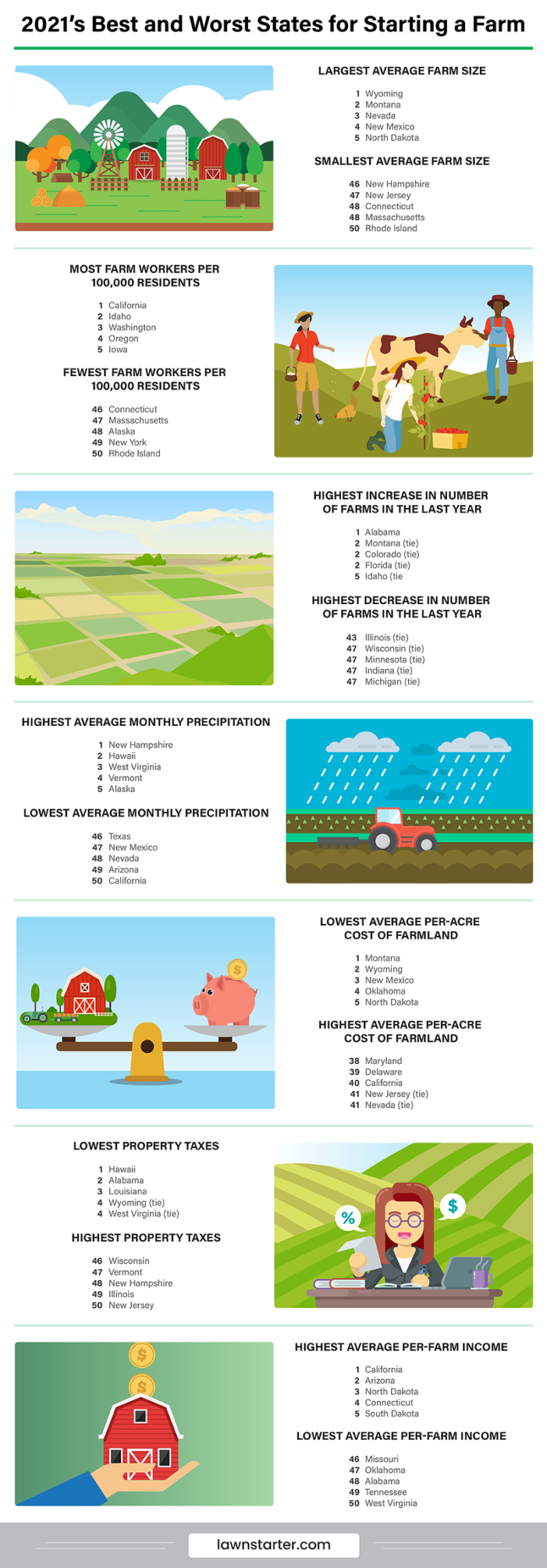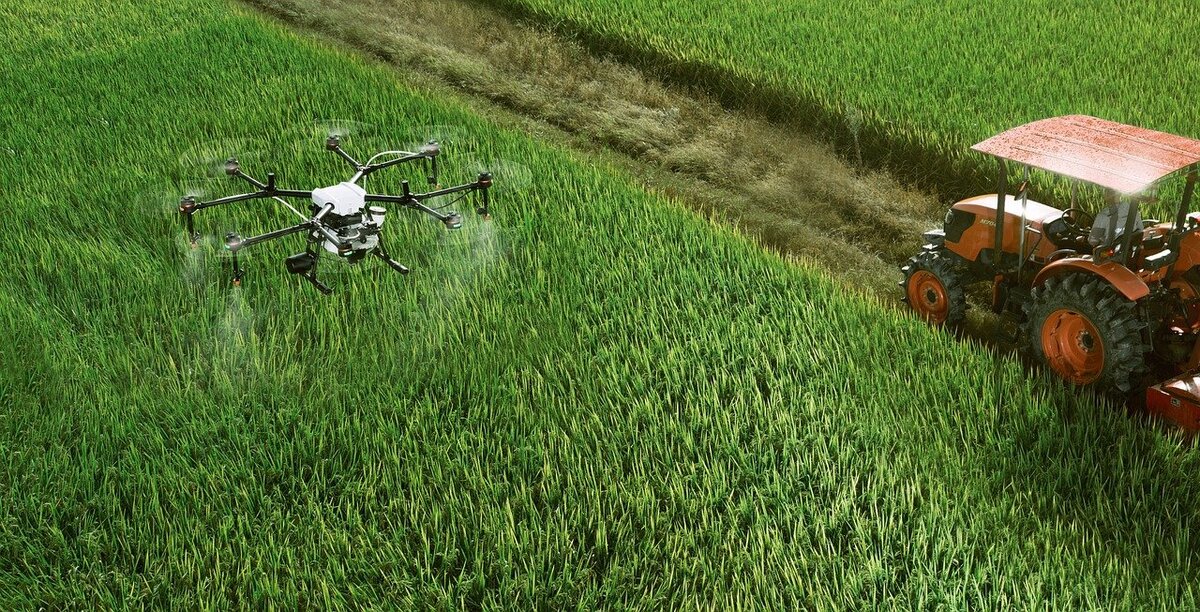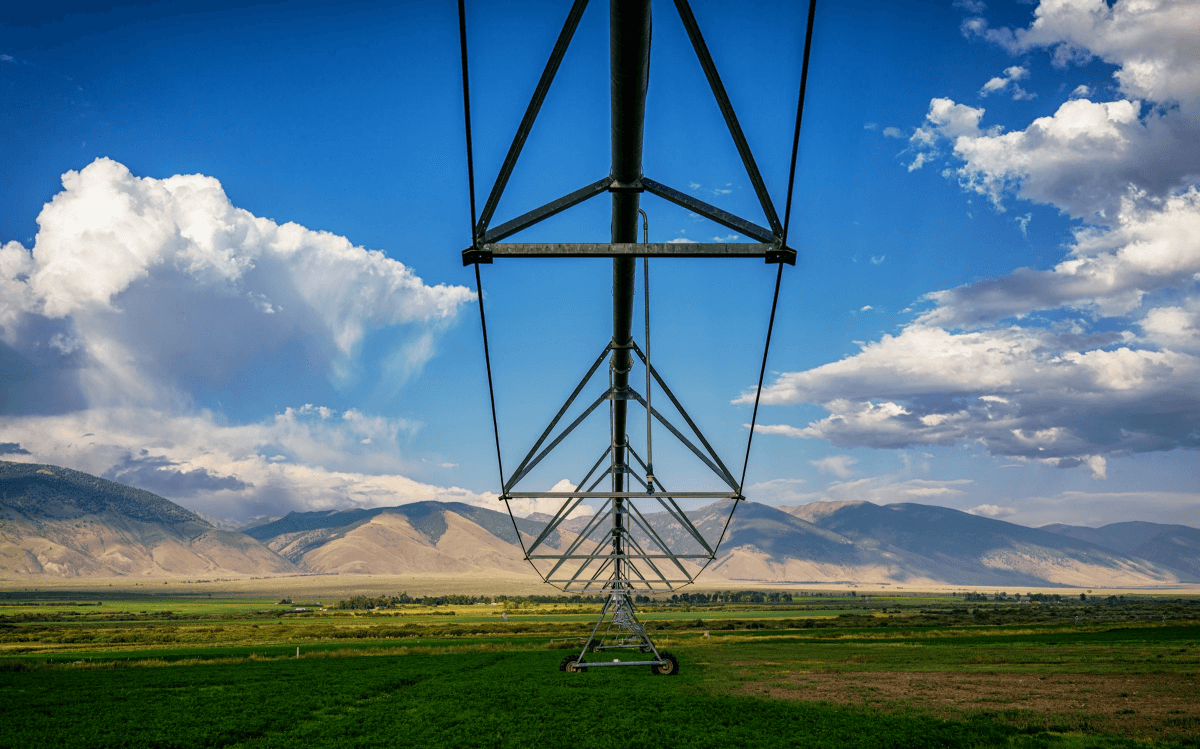
Farming and ranching aren’t the most glamorous jobs — you’re up before sunrise tilling the soil and milking the cows, and you work 365 days a year. Despite the rigorous work schedule, agriculture is among the most rewarding and essential professions.
But where do you have the highest chance of successfully starting a Green Acres life?
Ahead of Farmers Day, Oct. 12, LawnStarter compared the 50 states across 42 key metrics to rank 2021’s Best States to Start a Farm or Ranch.
We looked for states with existing farm communities to indicate viability, good infrastructure, and a suitable climate. We also compared the states based on overhead and ROI potential.
See which states are best for getting your hands dirty below, followed by some highlights and lowlights.
Table of Contents
State Rankings
See how each state fared in our ranking:
| OVERALL RANK | State | Overall Score | Viability Rank | Infrastructure Rank | Climate Rank | Environmental Hazards Rank | Personnel Rank | Costs Rank | ROI Potential Rank |
|---|---|---|---|---|---|---|---|---|---|
| 1 | Montana | 59.72 | 9 | 7 | 42 | 6 | 9 | 4 | 15 |
| 2 | Kansas | 58.78 | 5 | 1 | 40 | 9 | 12 | 22 | 32 |
| 3 | North Dakota | 57.35 | 2 | 23 | 46 | 2 | 10 | 15 | 13 |
| 4 | Texas | 57.32 | 1 | 6 | 48 | 48 | 24 | 20 | 12 |
| 5 | Oklahoma | 57.04 | 7 | 9 | 41 | 20 | 19 | 6 | 33 |
| 6 | South Dakota | 56.36 | 6 | 5 | 47 | 5 | 7 | 26 | 24 |
| 7 | Iowa | 56.06 | 3 | 2 | 28 | 17 | 5 | 45 | 20 |
| 8 | Kentucky | 55.07 | 10 | 8 | 8 | 28 | 18 | 17 | 18 |
| 9 | Colorado | 54.48 | 16 | 25 | 20 | 21 | 25 | 9 | 10 |
| 10 | Wyoming | 54.41 | 18 | 16 | 38 | 7 | 27 | 2 | 17 |
| 11 | Nebraska | 54.34 | 8 | 4 | 45 | 4 | 6 | 46 | 16 |
| 12 | Arkansas | 54.26 | 20 | 27 | 23 | 30 | 8 | 10 | 4 |
| 13 | New Mexico | 53.17 | 17 | 47 | 30 | 10 | 13 | 3 | 11 |
| 14 | Oregon | 53.08 | 23 | 21 | 19 | 29 | 4 | 27 | 5 |
| 15 | Tennessee | 52.88 | 11 | 12 | 13 | 44 | 43 | 13 | 34 |
| 16 | Idaho | 52.81 | 28 | 22 | 31 | 15 | 2 | 32 | 3 |
| 17 | Alabama | 52.37 | 22 | 13 | 26 | 39 | 17 | 7 | 22 |
| 18 | Missouri | 52.34 | 13 | 15 | 29 | 19 | 16 | 18 | 37 |
| 19 | Georgia | 52.12 | 29 | 11 | 17 | 33 | 15 | 16 | 14 |
| 20 | Minnesota | 51.93 | 21 | 3 | 43 | 3 | 22 | 33 | 21 |
| 21 | Washington | 51.89 | 37 | 30 | 44 | 13 | 3 | 24 | 2 |
| 22 | Louisiana | 50.84 | 41 | 18 | 21 | 50 | 28 | 8 | 7 |
| 23 | Mississippi | 50.39 | 40 | 20 | 39 | 36 | 14 | 12 | 9 |
| 24 | Wisconsin | 49.3 | 15 | 17 | 34 | 12 | 21 | 36 | 38 |
| 25 | Delaware | 49.01 | 32 | 10 | 2 | 46 | 32 | 35 | 6 |
| 26 | South Carolina | 48.89 | 35 | 33 | 9 | 43 | 37 | 5 | 30 |
| 27 | Virginia | 47.86 | 25 | 37 | 6 | 32 | 39 | 11 | 43 |
| 28 | Arizona | 47.83 | 24 | 39 | 16 | 25 | 11 | 39 | 8 |
| 29 | Ohio | 47.69 | 4 | 49 | 18 | 40 | 35 | 40 | 28 |
| 30 | West Virginia | 47.33 | 26 | 42 | 32 | 31 | 41 | 1 | 50 |
| 31 | Utah | 47 | 39 | 28 | 33 | 47 | 45 | 14 | 23 |
| 32 | North Carolina | 46.98 | 38 | 34 | 5 | 35 | 29 | 19 | 27 |
| 33 | Illinois | 46.97 | 14 | 14 | 35 | 34 | 30 | 48 | 26 |
| 34 | Florida | 46.56 | 34 | 36 | 3 | 42 | 26 | 28 | 19 |
| 35 | California | 45.83 | 48 | 19 | 4 | 37 | 1 | 50 | 1 |
| 36 | New York | 45.7 | 33 | 46 | 22 | 14 | 49 | 21 | 31 |
| 37 | Maryland | 45.66 | 29 | 32 | 25 | 23 | 34 | 37 | 25 |
| 38 | Indiana | 45.13 | 19 | 44 | 15 | 45 | 31 | 31 | 36 |
| 39 | Vermont | 44.8 | 27 | 29 | 27 | 8 | 23 | 41 | 49 |
| 40 | Hawaii | 44.38 | 43 | 45 | 1 | 1 | 20 | 29 | 41 |
| 41 | Michigan | 43.68 | 44 | 35 | 36 | 16 | 40 | 30 | 40 |
| 42 | Nevada | 42.43 | 36 | 31 | 37 | 49 | 42 | 44 | 35 |
| 43 | New Hampshire | 42.11 | 42 | 26 | 49 | 24 | 44 | 38 | 44 |
| 44 | Pennsylvania | 41.88 | 12 | 50 | 12 | 41 | 33 | 42 | 29 |
| 45 | Massachusetts | 39.94 | 47 | 48 | 7 | 27 | 47 | 25 | 45 |
| 46 | Maine | 39.59 | 45 | 43 | 14 | 11 | 38 | 34 | 47 |
| 47 | New Jersey | 39.25 | 31 | 24 | 24 | 38 | 35 | 49 | 48 |
| 48 | Connecticut | 38.08 | 46 | 40 | 10 | 26 | 46 | 47 | 39 |
| 49 | Rhode Island | 37.57 | 49 | 38 | 11 | 22 | 50 | 43 | 46 |
| 50 | Alaska | 36.13 | 50 | 41 | 50 | 18 | 48 | 23 | 42 |

Highlights and Lowlights
Montana: Ahead of the Herd
The Big Sky State earns the top spot in our ranking of 2021’s Best States to Start a Farm or Ranch. With agriculture its biggest industry, Montana’s victory comes as little surprise.
The state placed in the top 10 in five out of seven categories and No. 15 in ROI Potential. Montana trails only Wyoming in farm size, averaging a whopping 2,156 acres, and the average cost of an acre in the Treasure State is lowest in the U.S.
Although ranching is woven into the state’s cultural fabric, farming also contributes significantly to the state’s economy. Montana is a top supplier of beef, and it leads the nation’s production of organic certified wheat, dry peas, lentils, flax, and honey.
If you want the best of both worlds, Montana hits the sweet spot.
Great Plains: Great for Agriculture
Nine of our top 10 states are in the Great Plains, including several in the Corn Belt. Those regional names alone give away these states’ suitable farming qualities.
Coming in at No. 2 is Kansas, while Texas clocks in at No. 4, Oklahoma at No. 5, and Iowa in seventh place. Both Dakotas made it, too, at Nos. 3 and 6. Colorado (No. 9) and Wyoming (No. 10) round out the Plains states at the top.
But how specifically did this broad, sweeping landscape dominate the top of our ranking? Most of these states, such as Kansas, Oklahoma, and Texas, boast cheap land, large established farming communities for support, and highly developed infrastructure.
Move to the Great Plains, and you’ll be chasing cattle in no time.
The Last Frontier: Last in Farming
Alaska not only ranked at the very bottom of our ranking of top agricultural states, but it also finished last in two out of seven categories, Viability and Climate; third to last in Personnel; and in the worst 10 of Infrastructure and ROI Potential.
These results are hardly a shock. Although Alaska is the biggest state by land area, less than a quarter of a percent of the state’s 365 million acres is available for farming. Much of this can be attributed to the state’s generally unsuitable farming climate, brief growing season, and infertile soils.
In other words, you won’t grow many crops here — but you can grow some of the world’s biggest. Because of Alaska’s long daylight hours during summer, some vegetables grow to monstrous sizes: a 19-pound carrot, 76-pound rutabaga, and 172-pound cabbage.
Ask The Experts
Starting a farm or ranch can be challenging, especially if you have no previous experience.
To help you navigate the agricultural business landscape, we reached out to a panel of experts for wisdom. See what they had to say below.
- What are the top three reasons to start a farm or ranch today?
- What type of person is best suited to a career in agriculture?
- What will be the three biggest challenges to new farmers and ranchers over the next 3-5 years?
- Over the long-term, do you see more opportunity in direct-to-consumer farming or industrial supply-chain farming, which has not fared as well during the pandemic? Please explain.
- What’s your single most important tip for someone who wants to start a farm or ranch?




What are the top three reasons to start a farm or ranch today?
There is an ever-increasing demand for locally-grown produce.
In 2019, about 82% of the total population in the United States lived in cities and urban areas and it is predicted this percentage will keep increasing. Urbanization leads to a declining ratio of farmers to food consumers, which means there is a need for more farmers or to have existing farmers increase their production to meet the increasing demand.
One-third of US farmers are close to retirement age, and there is a need for farmers from the younger generation.
What type of person is best suited to a career in agriculture?
A person who likes to be close to nature, stay outside, get their hands dirty, and wants to be an entrepreneur,
What will be the three biggest challenges for new farmers and ranchers over the next 3-5 years?
Finding a customer base: It’s always challenging to find customers and target markets when starting a new business.
Competition from large retailers: The competition is intense because large-scale food suppliers have many advantages in terms of competitive pricing and efficient distribution.
Understanding consumers’ needs: consumers’ needs and wants are changing due to many uncertainties and the changing population structure, so it is challenging but very important to understand the consumers’ needs.
Over the long-term, do you see more opportunity in direct-to-consumer farming or industrial supply-chain farming, which has not fared as well during the pandemic? Please explain.
I would say both will have opportunities because consumers are not the same. Some consumers are price sensitive, whereas others pay more attention to product origin, local, organic, etc. Both direct-to-consumer farming and industrial supply-chain farming will find their segment of consumers.
What’s your single most important tip for someone who wants to start a farm or ranch?
Love farming. Loving what you do will go a long way.

What are the top three reasons to start a farm or ranch today?
Because you have the passion for it, it’s not something you kind of just do, even if it’s only part-time, you need passion for it.
What type of person is best suited to a career in agriculture?
Hard worker, responsible, the person who goes the extra mile and does not need the spotlight for doing good, hard work.
What will be the three biggest challenges for new farmers and ranchers over the next 3-5 years?
Price and market variability as we move into the post-covid economy. We are all still uncertain about how much consumer food demand has changed as a result of the pandemic.
Over the long-term, do you see more opportunity in direct-to-consumer farming or industrial supply-chain farming, which has not fared as well during the pandemic? Please explain.
Yes, food has moved into delivery just like much of retail, with more online shopping, home delivery, or curbside pick up. Small local foods have followed this trend and I expect consumers to stick with the buying channel even after the pandemic ends. The shopping and online technology is there.
The costly part is the shipping/delivery, the last mile. Transportation and logistics are all about efficiency, but that is where the small farmers and processors (meat, cheese processors) at the local level will struggle – driving around in your own van is costly compared to a large semi-trailer shipping food from CA to WI.
What’s your single most important tip for someone who wants to start a farm or ranch?
Try not to be too emotional about decision making, but go with what works and keeps your costs down. Yes, a new hay mower will look great and make you feel great, but a used one is likely a much better deal.
Keep your costs down and make rational decisions – most of farming is not about how things look or even how they work, but how much they cost to get the job done. Never underestimate the capacity of agriculture to oversupply any market and drive down prices –you will need to be able to survive low price years to make money in high price years.

What are the top three reasons to start a farm or ranch today?
Consumer demand is pushing for locally grown agricultural commodities.
Global awareness is encouraging everyone to reduce carbon emissions; buy local and ship local.
Mega-greenhouse structures are helping meet the need to grow more on less ground while being very environmentally friendly
What type of person is best suited to a career in agriculture?
Entrepreneurs willing to accept challenges and problem-solving thinkers are best suited for the greenhouse and green industry.
What will be the three biggest challenges for new farmers and ranchers over the next 3-5 years?
The greatest challenge growers are going to have is labor; finding quality laborers and being able to afford them while keeping the cost of production down.
I suspect government regulations will soon be more challenging for growers.
Finally, I suspect the cost of materials for products containing petroleum will increase significantly. We have seen prices increase and occasionally drop over the years, but it trends with the costs of petroleum.
Over the long-term, do you see more opportunity in direct-to-consumer farming or industrial supply-chain farming, which has not fared as well during the pandemic? Please explain.
I see community supported agriculture growing in popularity. Contract growing is great for farmers. They are guaranteed sales that usually require a deposit and that allows growers to manage cash flow a little easier.
What’s your single most important tip for someone who wants to start a farm or ranch?
Try to get start-up money with forgivable loans. Do your homework ahead of time to determine where your product will be sold. Prepare a firm business plan. Build a business, do not start an empire overnight.
Methodology
We ranked the 50 U.S. states (excluding the District of Columbia) from best (No. 1) to worst (No. 50) based on their overall scores (out of 100 possible points), averaged across all the weighted metrics listed below.
| Metric | Weighting | Min. Value | Max. Value | Best |
|---|---|---|---|---|
| Viability | ||||
| Farmland Area per State Area | 3 | 0.23% | 91.32% | Max. Value |
| Increase in Farmland Area Over Past Year | 2 | -500 | 0 | Max. Value |
| Number of Farms per State Area | 3 | 0.00 | 1.9 | Max. Value |
| Increase in Number of Farms in Past Year | 2 | -500 | 200 | Max. Value |
| Share of Family-Owned Farms | 3 | 93% | 98% | Max. Value |
| Average Farm Acreage | 3 | 55 acres | 2417 acres | Max. Value |
| Total Cropland Area | 2 | 25 acres | 29215 acres | Max. Value |
| Total Grassland Pasture Area | 2 | 7.19 acres | 104,603.14 acres | Max. Value |
| Number of USDA-Approved Slaughter and Rendering Establishments | 2 | 2.00 | 104.00 | Max. Value |
| CSAs (Community Supported Agriculture) per 100,000 Residents | 1 | 0.03 | 2.40 | Max. Value |
| Population Density in Rural Areas | 1 | 0.4 residents per sq. mi. | 154 residents per sq. mi. | Min. Value |
| Infrastructure | ||||
| Land Used for Rural Transportation | 2 | 11.09 acres | 1791.79 acres | Max. Value |
| Road Quality (Share of Major Roads in Poor or Mediocre Condition) | 2 | 14% | 77% | Min. Value |
| Water Quality (Total Number of Violations in Past Year) | 2 | 10 | 3,771 | Min. Value |
| Air Quality (Total Number of Violations in Past Year) | 2 | 1 | 313 | Min. Value |
| Phone Coverage | 2 | 4.30% | 100.00% | Max. Value |
| Potential for Solar Power (Index) | 1 | 0.67 | 1.19 | Max. Value |
| Potential for Wind Power (Index) | 1 | 192.36 | 1.34M | Max. Value |
| Share of Electricity from Renewable Sources | 1 | 2.52% | 99.82% | Max. Value |
| Share of Farms with Internet Access | 2 | 50% | 97% | Max. Value |
| Rural Health Clinics per 1,000 Square Miles | 2 | 0.08 | 6.88 | Max. Value |
| Number of Critical Access Hospitals | 2 | 3 | 88 | Max. Value |
| Climate | ||||
| Average Amount of Sunshine | 2 | 39.33% | 82% | Max. Value |
| Average Monthly Precipitation (in Inches) | 1 | 50.00 | 170.50 | Max. Value |
| Yearly Average Number of Very Hot Days (90 Degrees F or Higher) | 1 | 3.50 | 103.17 | Min. Value |
| Yearly Average Number of Very Cold Days (32 Degrees F or Lower) | 1 | 0.00 | 204.50 | Min. Value |
| Environmental Hazards | ||||
| Toxic Chemicals Release (per Square Mile) | 1 | 39.9 pounds | 3386.26 pounds | Min. Value |
| Risk-Screening Environmental Indicator Score | 1 | 333 | 79.44M | Min. Value |
| Natural Hazards Index | 1 | 9.21 | 15.78 | Min. Value |
| Personnel | ||||
| Farm Workers per 100,000 Residents | 2 | 6.80 | 1,461.20 | Max. Value |
| Costs | ||||
| Average Per-Acre Cost of Farmland | 3 | $1,050 | $14,800 | Min. Value |
| Yearly Average Increase in Per-Acre Farmland Price | 2 | -$5.00 | $557.50 | Min. Value |
| Per-Acre Farmland Rental Rate | 2 | $35 | $331 | Min. Value |
| Yearly Average Increase in Per-Acre Farmland Rental Rate | 1 | -$8.75 | $41.50 | Min. Value |
| Property Taxes | 3 | 0.30% | 2.21% | Min. Value |
| Average Per-Farm Annual Production Expenses | 2 | $28,420 | $535,669 | Min. Value |
| Cost of Living Index | 1 | 86.10 | 192.90 | Min. Value |
| ROI Potential | ||||
| Annual Farmland Returns | 3 | 0.04% | 8.80% | Max. Value |
| Average Per-Farm Annual Income | 2 | $7,905 | $66,671 | Max. Value |
| Average Per-Farm Net Cash Annual Income | 2 | $2,519 | $277,316 | Max. Value |
| Average Per-Farm Annual Receipts from Federal Programs | 2 | $4,609 | $38,624 | Max. Value |
| Total Annual Market Value of Agricultural Products Sold | 1 | $57.99M | $45.15B | Max. Value |
Sources: AcreTrader, National Center for Disaster Preparedness, National Oceanic and Atmospheric Administration, National Transportation Research Nonprofit (TRIP), Nebraska Department of Environment & Energy, Rural Health Information Hub, Tax Foundation, U.S. Bureau of Labor Statistics, U.S. Census Bureau, U.S. Department of Agriculture, U.S. Department of Energy, U.S. Energy Information Administration, U.S. Environmental Protection Agency, WhistleOut and World Population Review
Why This Study Matters
The pandemic made clear that farmers and ranchers are more vital than ever to maintaining our food supply. When it was hard to find toilet paper, there were always fruits, vegetables, and meat for lunch and dinner.
But like many other sectors of the economy, the agriculture industry currently suffers from a massive labor shortage. The consequences could be dire — we need more children of the corn, as well as more citrus growers, calf ropers, and steer herders.
Besides the opportunity to fill this critical employment gap, the financial incentive to join the agriculture industry is stronger than ever: You can make green by growing green crops — this includes marijuana in states where that’s legal.
At the start of 2021, farmers were forecasted to see profits for the first time in many years. Profits from farm exports, in particular, are expected to hit a new record in 2022 after an already record-setting 2021.
So if you’re looking for a career transition, buy the farm or saddle up your horses — the time to enter the agriculture market is now.
Main Photo Credit: Budimir Jevtic | Shutterstock




